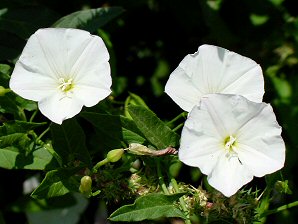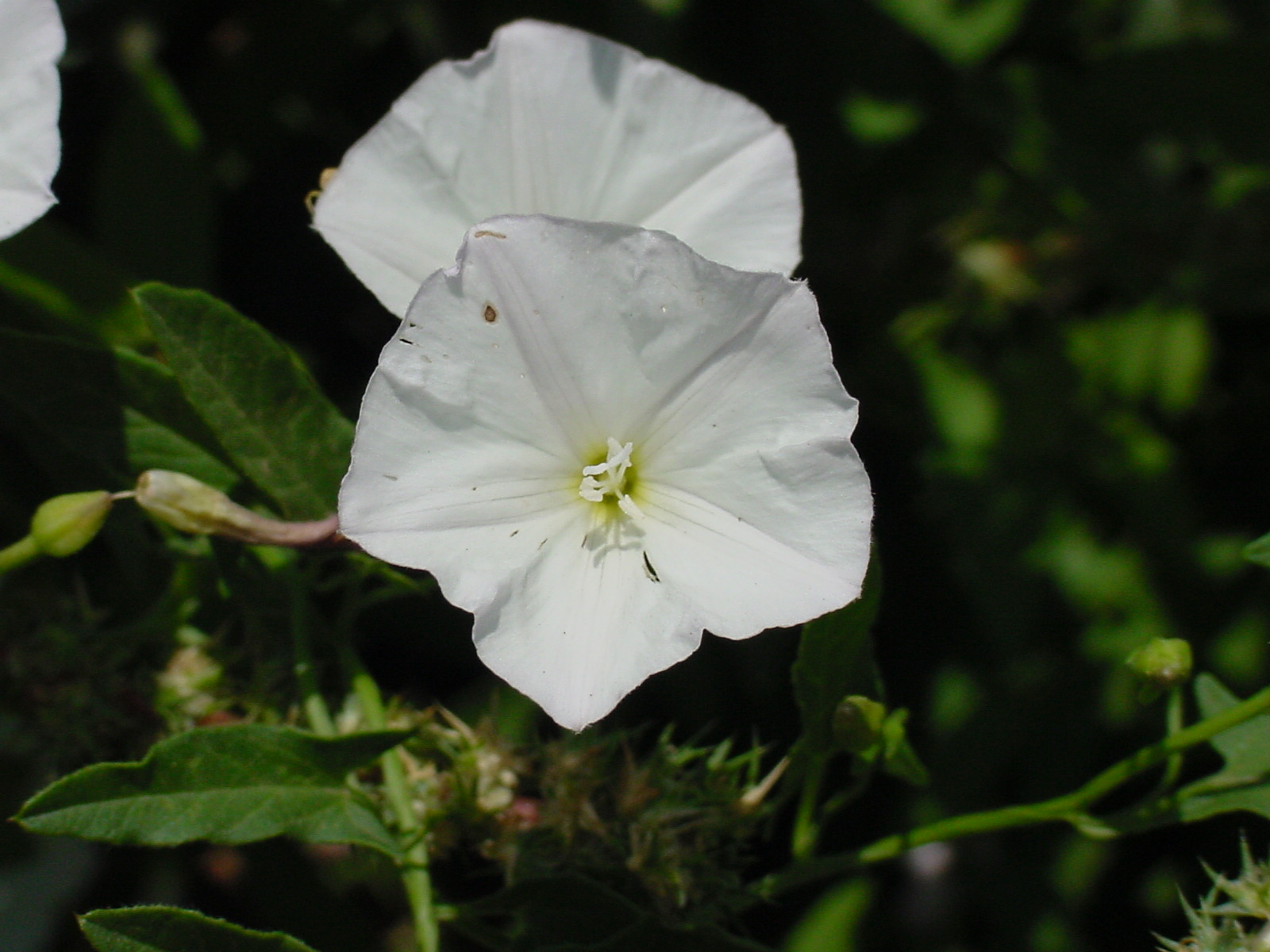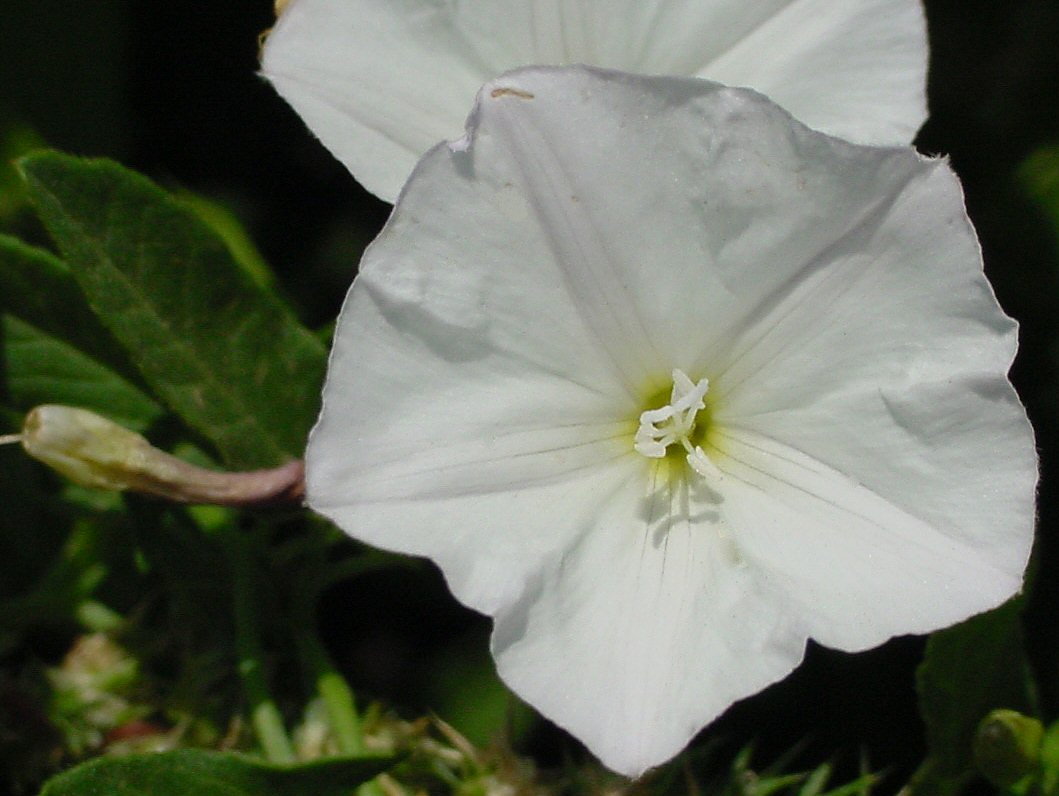Arizona Wild Flowers
Pictures, Photos, Images
Descriptions, Information, Reviews.
Hedge Bindweed, Convolvulus sepium.
We Are Proud Of Our SafeSurf Rating!
Click On Any Of The Following Links By Amazon.Com
For Books, & Videos About Wildflowers Of Arizona & The Southwest USA. No Obligation!
 |
| Hedge Bindweed, Convolvulus sepium. Photo Taken July 21, 2003 In Glendale, Arizona. |
|---|
 | |
| Hedge Bindweed. | Convolvulus sepium. |
|---|---|
 |  |
| An Invasive Weed. | Roots Over 15 Feet Deep. |
Hedge Bindweed.
We wish to thank Wikipedia, the free encyclopedia for some of the information on this page. We share images and information with Wikipedia. Calystegia sepium or Hedge Bindweed is also called Larger Bindweed, Rutland beauty, Bugle Vine, or Heavenly Trumpets. Formerly known as; Convolvulus sepium, is a species of bindweed, with a distribution throughout the temperate Northern Hemisphere in Europe, Asia, northwestern Africa, and North America, and in the temperate Southern Hemisphere in Australia, and Argentina in South America. Hedge Bindweed is a native perennial vine that is up to about 10 feet long. Its twining stems are light green or red. Its leaves are about 4 -5 inches long and about 2 - 3 inches wide. They often have an arrowhead shape, which is deeply incised at the base. Sometimes, they are cordate, deltoid, or ovate, with different forms occurring upon the same plant. The flowering buds are white or light lavender, from which funnel-shaped flowers unfurl that assume the same colors. Each flower is about 2� - 3 inches wide with a yellow throat, from which its sexual organs barely protrude, appearing as a small white spike. The root system is fibrous and rhizomatous, and may extend into the ground up to about 10 - 15 feet long. Hedge Bindweed is normally found at the edges of moist to mesic prairies, thickets, woodland borders, and floodplain areas near lakes and rivers. In developed areas, it is found near pastures, abandoned fields, fence rows, urban waste areas, or areas along roadsides and railroads tracks. Convolvulus sepium is on the Arizona Department Of Agriculture list of list of noxious weeds that Arizona wants to keep out. Bindweed is a common weed and a problem for many farmers. The weed damags crops by wrapping itself around plants. Growing all over the world, it is sometimes called "the cancer of weeds.� On the good side the plant may have some medicinal purposes. A resin is made from the root which has the following medicinal properties: it promotes the discharge of bile from the system, it increase the secretion and discharge of urine, it has the effect of loosening or opening the intestines, hence stimulating evacuation of faeces and so relieving one from constipation. A proteoglycan mixture (PGM) found in bindweed has been tested to be 100 times more effective at preventing new blood vessel growth than shark cartilage by weight. This testing was done in chicken egg chorioallantoic membranes and was effective in a dose-dependent manner. So what does all that mean? Well, it could be helpfull in the shrinkage of tumors and the assistance in preventing macular degeneration. No testing on humans has been done yet and we would not recommend the use of Bindweed.
Quick Notes:
Height: About 3 to 10 feet long.
Flowers: From 1 1/2 " - 2 1/2" wide. They are are usually white with white stripes, but can be pink with white stripes. They are funnel-shaped. They have 5 petals, fused together; calyx is 5-lobed, enclosed in 2 pale green bracts.They have a sweet vanilla scent.
Flowering Time: May-September.
Leaves: Arrow-shaped. About 4 -5 inches long, and about 2 - 3 inches wide. Alternatively arranged along one side of the stem.
Found: Native of the USA (AK, AL, AR, AZ, CA, CO, CT, DC, DE, FL, GA, IA, ID, IL, IN, KS, KY, LA, MA, MD, ME, MI, MN, MO, MS, MT, NC, ND, NE, NH, NJ, NM, NV, NY, OH, OK, OR, PA, RI, SC, SD, TN, TX, UT, VA, VT, WA, WI, WV, WY). Also native of Canada in (AB, BC, MB, NB, NF, NS, ON, PE, QC, SK). Also found in Northern Mexico: Baja Norte, Chihuahua, Coahuila, Durango, Nuevo Leon, Sonora, Tamaulipas, Zacatecas. And Southern Mexico: Oaxaca, & Puebla.
Hardiness:
Soil pH requirements:
Sun Exposure:
Elevation: 0 to 2,000 feet.
Habitat: On cultivated, waste and fallow land, roadsides, scrub and, occasionally, on sand-dunes. It also can be found in perennial fields and on cultivated land.
Miscellaneous: Flowering Photos Taken July 21, 2003 In Glendale, Arizona.
|
We Are Proud Of Our SafeSurf Rating!
Click On Any Of The Following Links By Amazon.Com
For Books, & Videos About Wildflowers Of Arizona & The Southwest USA. No Obligation!
| © 1966 - Present, Audrey, Eve, & George DeLange |